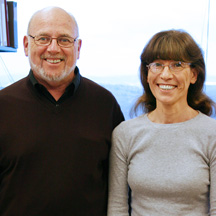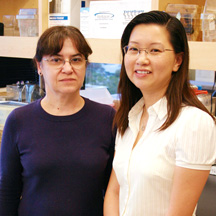

White Blood Cells Deliver Boost to Tumors
By Eric Sauter
Scientists at The Scripps Research Institute have found that a specific type of white blood cell carries with it an unusually potent catalyst of tumor growth. The catalyst promotes angiogenesis, the formation of new blood vessels, which are critical to tumor growth.
The study was published in an advance online edition of the journal Proceedings of the National Academy of Sciences (PNAS) on December 11.
The catalyst, the protease matrix metalloproteinases type 9 or proMMP-9, is carried by inflammatory neutrophils, white blood cells known as granulocytes that are filled with granules or tiny sacs of enzymes, including proMMP-9, that cells use to attack various microorganisms. When released by the neutrophils, proMMP-9 stimulates the growth of new blood vessels at the tumor site.
These findings provide the first concrete in vivo evidence that infiltrating neutrophils, in contrast to other cell types, deliver a potent pro-angiogenic boost directly to the tumor site, raising the possibility that neutrophils and their angiogenic payload could be used as targets for future cancer therapies.
"Our analysis focused on finding a biochemical explanation for why proMMP-9 released by neutrophils acts as a powerful pro-angiogenic molecule," said James Quigley, a Scripps Research scientist and professor of cell biology, whose laboratory conducted the study. "What we determined is that neutrophils are the only cells that release proMMP-9 unencumbered by TIMP1—an angiogenic inhibitor that binds tightly to proMMP-9. The TIMP-1-free status of neutrophil proMMP-9 is the major determining factor for such high levels of angiogenic activity."
The generation of new blood vessels is a critical step in the pathology of tumor progression. In recent years, angiogenesis has been the focus of intense interest as a novel way to prevent tumor growth by, in essence, starving the tumor of oxygen and other nutrients essential for tumor expansion.
Matrix metalloproteinases are part of a superfamily of enzymes that play an important role in tissue remodeling by breaking down proteins in the extracellular matrix, the connective tissue that provides structural support for cells. Recent studies have shown that abnormal MMP expression is a contributing factor in a number of inflammatory diseases, including rheumatoid arthritis, tumor invasion and metastasis, and inflammatory boweldisease.
Neutrophils act as first responders to inflammation. As the first cells to migrate to the inflammatory site, they release their payloads of enzymes, sparking the angiogenic process and preparing the site for macrophage influx and further tissue repair.
Tremendous Catalytic Power
"It has been known for some time that proMMP-9 is an important part of the neutrophil content," Quigley said. "Our study demonstrates the mechanistic link between the delivery of proMMP-9 and its activation and catalytic functions at the site of angiogenesis. But neutrophils do not synthesize proMMP-9 on demand like other cells—they pre-synthesize it during their maturation in the bone marrow and store it in their granules. And these precursor cells do not appear to co-express TIMP-1"
The catalytic power of these proMMP-9 loaded granules is striking, Quigley said. In the study, as few as 10,000 to 30,000 neutrophils increased the level of angiogenesis as much as five fold in as little as three days. The study also found that the contents of the neutrophil granules, which are released rapidly, contained the majority (if not the entirety) of the pro-angiogenic enzymes.
"The experimental model we used is focused on delivering a concentrated number of neutrophils to a very small part of a developing chicken embryo," Quigley pointed out. "Such a large increase in angiogenic activity from what is a relatively small number of neutrophils is highly significant."
Links to Cancer
The association between inflammatory cells such as macrophages and neutrophils and pathologic angiogenesis has become well accepted as a number of chronic inflammatory diseases have been increasingly linked to malignancy. A number of studies have also linked neutrophil proMMP-9 to pathological angiogenesis and tumor progression.
"Neutrophils, acting alone or in concert with macrophages, are a major contributor to carcinogenesis and tumor expansion," Quigley said. "In fact, studies have shown that knocking down neutrophils with anti-granulocyte antibodies reduced both growth factor- and tumor-induced angiogenesis in mouse models. Our study provides more evidence of that direct link."
The study noted that the process of angiogenesis called for the activation of specific mechanisms to overcome the natural angiostatic state of the vasculature in most adult tissues.
Activation of the angiogenic switch includes, at least in part, selective remodeling of the tissue's extracellular matrix before the endothelium can form the new blood vessels. In addition to matrix remodeling, a number of different matrix metalloproteinases have been shown to process and generate angiogenic regulatory molecules.
While scientists believe proMMP-9 is activated in several ways, possibly including self-activation, they do not yet know which mode of activation is dominant in the tissues, but what is critical is the unique TIMP-1-free nature of neutrophil proMMP-9 allows for a more rapid and efficient activation of the proenzyme.
In addition to Quigley, authors of the new study, Human Neutrophils Uniquely Release TIMP-Free MMP-9 To Provide A Potent Catalytic Stimulator Of Angiogenesis, include Veronica C. Ardi, Tatyana A. Kupriyanova, and Elena I. Deryugina of The Scripps Research Institute. The research was supported by the National Institutes of Health.
For more information on the study, see PNAS at http://www.pnas.org/cgi/content/abstract/0706438104v1.
Send comments to: mikaono[at]scripps.edu


Authors of the new PNAS paper are (clockwise from top left)
Professor James Quigley, Staff Scientist Elena I. Deryugina, Research
Associate Veronica C. Ardi, and Research Associate Tatyana A. Kupriyanova.
